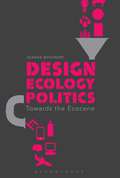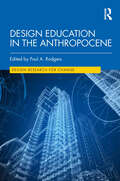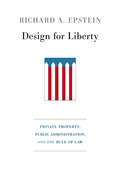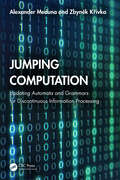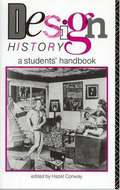- Table View
- List View
Design Dispersed: Forms of Migration and Flight (Design #44)
by Burcu Dogramaci Kerstin PintherDesign Dispersed pursues the complex and heterogeneous connections between migration and design in the 20th and 21st centuries. The edited volume gathers contributions by international researchers and curators on the question of how design practices and (historical) objects articulate, respond to and critically reflect on migration, flight and displacement: Besides a collage which highlights the aesthetic effects resulting from the networking, overlapping and mixing of forms, another strand of the book looks at the political and social dimensions of design. How are design objects material modes of a critical inquiry on movements of people and things? What role do object trajectories play in the émigré movements of the 1930s and 1940s? Other texts follow the question of how migrants and refugees form their experience and political fight for acceptance into design and architectural productions. A final essay contributes to wordings and projections - what vocabulary do we need in order to adequately think and write about a design dispersed?
Design, Displacement, Migration: Spatial and Material Histories (Routledge Research in Design History)
by Sarah A. LichtmanDesign, Displacement, Migration: Spatial and Material Histories gathers a collection of scholarly and creative voices—spanning design, art, and architectural history; design studies; curation; poetry; activism; and social sciences––to interrogate the intersections of design and displacement. The contributors foreground objects, spaces, visual, and material practices and consider design’s role in the empire, the state, and various colonizing regimes in controlling the mass movement of people, things, and ideas across borders, as well as in social acts that resist forced mobility and immobility, or enact new possibilities. By consciously surfacing echoes, rhymes, and dissonances among varied histories, this volume highlights local specificity while also accounting for the vectors of displacement and design across borders and histories. Design, Displacement, Migration: Spatial and Material Histories shows displacement to be a lens for understanding space and materiality and vice versa, particularly within the context of modernity and colonialism. This book will be of interest to scholars working in design history, design studies, architectural history, art history, urban studies, and migration studies.
Design, Displacement, Migration: Spatial and Material Histories (Routledge Research in Design History)
by Sarah A. Lichtman Jilly TraganouDesign, Displacement, Migration: Spatial and Material Histories gathers a collection of scholarly and creative voices—spanning design, art, and architectural history; design studies; curation; poetry; activism; and social sciences––to interrogate the intersections of design and displacement. The contributors foreground objects, spaces, visual, and material practices and consider design’s role in the empire, the state, and various colonizing regimes in controlling the mass movement of people, things, and ideas across borders, as well as in social acts that resist forced mobility and immobility, or enact new possibilities. By consciously surfacing echoes, rhymes, and dissonances among varied histories, this volume highlights local specificity while also accounting for the vectors of displacement and design across borders and histories. Design, Displacement, Migration: Spatial and Material Histories shows displacement to be a lens for understanding space and materiality and vice versa, particularly within the context of modernity and colonialism. This book will be of interest to scholars working in design history, design studies, architectural history, art history, urban studies, and migration studies.
Design, Ecology, Politics: Towards the Ecocene
by Joanna BoehnertDesign, Ecology, Politics links social and ecological theory to design theory and practice, critiquing the ways in which the design industry perpetuates unsustainable development.Boehnert argues that when design does engage with issues of sustainability, this engagement remains shallow, due to the narrow basis of analysis in design education and theory. The situation is made more severe by design cultures which claim to be apolitical. Where design education fails to recognise the historical roots of unsustainable practice, it reproduces old errors. New ecologically informed design methods and tools hold promise only when incorporated into a larger project of political change. Design, Ecology, Politics describes how ecological literacy challenges many central assumptions in design theory and practice.By bringing design, ecology and socio-political theory together, Boehnert describes how power is constructed, reproduced and obfuscated by design in ways which often cause environmental harms. She uses case studies to illustrate how communication design functions to either conceal or reveal the ecological and social impacts of current modes of production. The transformative potential of design is dependent on deep-reaching analysis of the problems design attempts to address. Ecologically literate and critically engaged design is a practice primed to facilitate the creation of viable, sustainable and just futures. With this approach, designers can make sustainability not only possible, but attractive.
Design, Ecology, Politics: Towards the Ecocene
by Joanna BoehnertDesign, Ecology, Politics links social and ecological theory to design theory and practice, critiquing the ways in which the design industry perpetuates unsustainable development.Boehnert argues that when design does engage with issues of sustainability, this engagement remains shallow, due to the narrow basis of analysis in design education and theory. The situation is made more severe by design cultures which claim to be apolitical. Where design education fails to recognise the historical roots of unsustainable practice, it reproduces old errors. New ecologically informed design methods and tools hold promise only when incorporated into a larger project of political change. Design, Ecology, Politics describes how ecological literacy challenges many central assumptions in design theory and practice.By bringing design, ecology and socio-political theory together, Boehnert describes how power is constructed, reproduced and obfuscated by design in ways which often cause environmental harms. She uses case studies to illustrate how communication design functions to either conceal or reveal the ecological and social impacts of current modes of production. The transformative potential of design is dependent on deep-reaching analysis of the problems design attempts to address. Ecologically literate and critically engaged design is a practice primed to facilitate the creation of viable, sustainable and just futures. With this approach, designers can make sustainability not only possible, but attractive.
Design Education in the Anthropocene (Design Research for Change)
by Paul A. RodgersThis volume examines emerging practice and research in design education rooted in the context of significant global issues.A diverse set of international contributors present novel design education research that seeks to make significant social, economic, cultural and environmental change. Topics covered include fashion, sustainability, creativity, social justice, museum education, climate change, environmentalism, and empathy. The chapters draw a link between current research practice and theory and future challenges for the field.The book will be of interest to scholars working in communication design, graphic design, design research, and information design.
Design Education in the Anthropocene (Design Research for Change)
This volume examines emerging practice and research in design education rooted in the context of significant global issues.A diverse set of international contributors present novel design education research that seeks to make significant social, economic, cultural and environmental change. Topics covered include fashion, sustainability, creativity, social justice, museum education, climate change, environmentalism, and empathy. The chapters draw a link between current research practice and theory and future challenges for the field.The book will be of interest to scholars working in communication design, graphic design, design research, and information design.
Design for Liberty: Private Property, Public Administration, and the Rule of Law
by Richard A. EpsteinFollowing a vast expansion in the twentieth century, government is beginning to creak at the joints under its enormous weight. The signs are clear: a bloated civil service, low approval ratings for Congress and the President, increasing federal-state conflict, rampant distrust of politicians and government officials, record state deficits, and major unrest among public employees. In this compact, clearly written book, the noted legal scholar Richard Epstein advocates a much smaller federal government, arguing that our over-regulated state allows too much discretion on the part of regulators, which results in arbitrary, unfair decisions, rent-seeking, and other abuses. Epstein bases his classical liberalism on the twin pillars of the rule of law and of private contracts and property rights—an overarching structure that allows private property to keep its form regardless of changes in population, tastes, technology, and wealth. This structure also makes possible a restrained public administration to implement limited objectives. Government continues to play a key role as night-watchman, but with the added flexibility in revenues and expenditures to attend to national defense and infrastructure formation. Although no legal system can eliminate the need for discretion in the management of both private and public affairs, predictable laws can cabin the zone of discretion and permit arbitrary decisions to be challenged. Joining a set of strong property rights with sound but limited public administration could strengthen the rule of law, with its virtues of neutrality, generality, clarity, consistency, and forward-lookingness, and reverse the contempt and cynicism that have overcome us.
Design for People Living with Dementia (Design Research for Change)
by Paul A. RodgersThis book presents the latest research that shows how design thinking, making, and acting contribute to the co-designing and development of products, spaces, and services with people living with dementia. We know that there is currently no cure for the 130+ kinds of dementia that millions of people live with all over the world, but the designed interventions such as the products, spaces, and services described in this book can address stigma, isolation, loss of confidence, and raise awareness and greater understanding of dementia. This book showcases a range of innovative and creative design interventions that have been developed to break the cycle of well-established opinions, strategies, mindsets, and ways of doing that tend to remain unchallenged in the health and social care of people living with dementia. The book will be of interest to scholars working in product design, service design, experience design, architecture, design research, information design, user-centred design, and design for health.
Design for People Living with Dementia (Design Research for Change)
by Paul A. RodgersThis book presents the latest research that shows how design thinking, making, and acting contribute to the co-designing and development of products, spaces, and services with people living with dementia. We know that there is currently no cure for the 130+ kinds of dementia that millions of people live with all over the world, but the designed interventions such as the products, spaces, and services described in this book can address stigma, isolation, loss of confidence, and raise awareness and greater understanding of dementia. This book showcases a range of innovative and creative design interventions that have been developed to break the cycle of well-established opinions, strategies, mindsets, and ways of doing that tend to remain unchallenged in the health and social care of people living with dementia. The book will be of interest to scholars working in product design, service design, experience design, architecture, design research, information design, user-centred design, and design for health.
Design for Regenerative Cities and Landscapes: Rebalancing Human Impact And Natural Environment (Contemporary Urban Design Thinking Ser.)
by Rob RoggemaDesign for Tall Buildings in China: Past, Present, and Future Fire and Life Safety (The Society of Fire Protection Engineers Series)
by Fang LIThis book provides readers an approach to overall fire and life-life design of high-rise buildings in a way that meets all stakeholders’ objectives. It describes how China began constructing tall and super tall buildings decades ago and imparts many lessons learned through those experiences along with similar projects from all over the world. The author explains the technology and culture for tall building design in China as a context for how the world seeks to ensure fire and life safety in these remarkable structures.
Design for the Crowd: Patriotism and Protest in Union Square
by Joanna Merwood-SalisburySituated on Broadway between Fourteenth and Seventeenth Streets, Union Square occupies a central place in both the geography and the history of New York City. Though this compact space was originally designed in 1830 to beautify a residential neighborhood and boost property values, by the early days of the Civil War, New Yorkers had transformed Union Square into a gathering place for political debate and protest. As public use of the square changed, so, too, did its design. When Frederick Law Olmsted and Calvert Vaux redesigned the park in the late nineteenth century, they sought to enhance its potential as a space for the orderly expression of public sentiment. A few decades later, anarchists and Communist activists, including Emma Goldman, turned Union Square into a regular gathering place where they would advocate for radical change. In response, a series of city administrations and business groups sought to quash this unruly form of dissidence by remaking the square into a new kind of patriotic space. As Joanna Merwood-Salisbury shows us in Design for the Crowd, the history of Union Square illustrates ongoing debates over the proper organization of urban space—and competing images of the public that uses it. In this sweeping history of an iconic urban square, Merwood-Salisbury gives us a review of American political activism, philosophies of urban design, and the many ways in which a seemingly stable landmark can change through public engagement and design. Published with the support of Furthermore: a program of the J. M. Kaplan Fund.
Design for the Crowd: Patriotism and Protest in Union Square
by Joanna Merwood-SalisburySituated on Broadway between Fourteenth and Seventeenth Streets, Union Square occupies a central place in both the geography and the history of New York City. Though this compact space was originally designed in 1830 to beautify a residential neighborhood and boost property values, by the early days of the Civil War, New Yorkers had transformed Union Square into a gathering place for political debate and protest. As public use of the square changed, so, too, did its design. When Frederick Law Olmsted and Calvert Vaux redesigned the park in the late nineteenth century, they sought to enhance its potential as a space for the orderly expression of public sentiment. A few decades later, anarchists and Communist activists, including Emma Goldman, turned Union Square into a regular gathering place where they would advocate for radical change. In response, a series of city administrations and business groups sought to quash this unruly form of dissidence by remaking the square into a new kind of patriotic space. As Joanna Merwood-Salisbury shows us in Design for the Crowd, the history of Union Square illustrates ongoing debates over the proper organization of urban space—and competing images of the public that uses it. In this sweeping history of an iconic urban square, Merwood-Salisbury gives us a review of American political activism, philosophies of urban design, and the many ways in which a seemingly stable landmark can change through public engagement and design. Published with the support of Furthermore: a program of the J. M. Kaplan Fund.
Design for the Crowd: Patriotism and Protest in Union Square
by Joanna Merwood-SalisburySituated on Broadway between Fourteenth and Seventeenth Streets, Union Square occupies a central place in both the geography and the history of New York City. Though this compact space was originally designed in 1830 to beautify a residential neighborhood and boost property values, by the early days of the Civil War, New Yorkers had transformed Union Square into a gathering place for political debate and protest. As public use of the square changed, so, too, did its design. When Frederick Law Olmsted and Calvert Vaux redesigned the park in the late nineteenth century, they sought to enhance its potential as a space for the orderly expression of public sentiment. A few decades later, anarchists and Communist activists, including Emma Goldman, turned Union Square into a regular gathering place where they would advocate for radical change. In response, a series of city administrations and business groups sought to quash this unruly form of dissidence by remaking the square into a new kind of patriotic space. As Joanna Merwood-Salisbury shows us in Design for the Crowd, the history of Union Square illustrates ongoing debates over the proper organization of urban space—and competing images of the public that uses it. In this sweeping history of an iconic urban square, Merwood-Salisbury gives us a review of American political activism, philosophies of urban design, and the many ways in which a seemingly stable landmark can change through public engagement and design. Published with the support of Furthermore: a program of the J. M. Kaplan Fund.
Design for the Crowd: Patriotism and Protest in Union Square
by Joanna Merwood-SalisburySituated on Broadway between Fourteenth and Seventeenth Streets, Union Square occupies a central place in both the geography and the history of New York City. Though this compact space was originally designed in 1830 to beautify a residential neighborhood and boost property values, by the early days of the Civil War, New Yorkers had transformed Union Square into a gathering place for political debate and protest. As public use of the square changed, so, too, did its design. When Frederick Law Olmsted and Calvert Vaux redesigned the park in the late nineteenth century, they sought to enhance its potential as a space for the orderly expression of public sentiment. A few decades later, anarchists and Communist activists, including Emma Goldman, turned Union Square into a regular gathering place where they would advocate for radical change. In response, a series of city administrations and business groups sought to quash this unruly form of dissidence by remaking the square into a new kind of patriotic space. As Joanna Merwood-Salisbury shows us in Design for the Crowd, the history of Union Square illustrates ongoing debates over the proper organization of urban space—and competing images of the public that uses it. In this sweeping history of an iconic urban square, Merwood-Salisbury gives us a review of American political activism, philosophies of urban design, and the many ways in which a seemingly stable landmark can change through public engagement and design. Published with the support of Furthermore: a program of the J. M. Kaplan Fund.
Design for the Unthinkable World: Strange Ecology and Unwelcome Change (Design Research for Change)
by Craig Bremner A. Paul Rodgers Giovanni InnellaThis edited book contests that if design’s raison d'être is to make things better, then the object of design has always been, remains and can only be a changed world and our relationship to it – the world-for-us.Each chapter was written by carefully selected researchers and practitioners who span geographical, disciplinary, and methodological boundaries in their work. Contributors skilfully examine the case that, while this once might have been seen to be a worthy objective (how else to effect a preferred state and/or pursue the project for the better world?), now the role of designing must cease to service design for change in the manner in which it has been doing. Chapters explore how designing itself might change to explore the possibilities that might exist for the design of what-might-not-become in an unthinkable-world; what Eugene Thacker calls a world-without-us. This world-without-us does not mean a world devoid of humans or an interstellar world, but a world we project that continues to revolve around the sun but no longer revolves around us.This book will be of interest to scholars working in design research, design ecology, product design, service design, experience design, architecture, and information design.
Design for the Unthinkable World: Strange Ecology and Unwelcome Change (Design Research for Change)
This edited book contests that if design’s raison d'être is to make things better, then the object of design has always been, remains and can only be a changed world and our relationship to it – the world-for-us.Each chapter was written by carefully selected researchers and practitioners who span geographical, disciplinary, and methodological boundaries in their work. Contributors skilfully examine the case that, while this once might have been seen to be a worthy objective (how else to effect a preferred state and/or pursue the project for the better world?), now the role of designing must cease to service design for change in the manner in which it has been doing. Chapters explore how designing itself might change to explore the possibilities that might exist for the design of what-might-not-become in an unthinkable-world; what Eugene Thacker calls a world-without-us. This world-without-us does not mean a world devoid of humans or an interstellar world, but a world we project that continues to revolve around the sun but no longer revolves around us.This book will be of interest to scholars working in design research, design ecology, product design, service design, experience design, architecture, and information design.
Design History: Students' Handbook (PDF)
by Hazel ConwayHazel Conway introduces the student new to the subject to different areas of design history and shows some of the ways in which it can be studied and some of its delights and difficulties. No background knowledge of design history, art or architecture is assumed.
Design History: A Students' Handbook
by Hazel ConwayHazel Conway introduces the student new to the subject to different areas of design history and shows some of the ways in which it can be studied and some of its delights and difficulties. No background knowledge of design history, art or architecture is assumed.
Design History: A Students' Handbook
by Hazel ConwayHazel Conway introduces the student new to the subject to different areas of design history and shows some of the ways in which it can be studied and some of its delights and difficulties. No background knowledge of design history, art or architecture is assumed.
Design History and the History of Design
by John A. WalkerAn essential overview as well as a theoretical critique for all students of design history. Walker studies the intellectual discipline of Design History and the issues that confront scholars writing histories of design. *BR**BR*Taking his approach from a range of related fields, he discusses the problems of defining design and writing history. He considers the different methods that leading scholars have used in the absence of a theoretical framework, and looks critically at a number of histories of design and architecture.
Design History and the History of Design
by John A. WalkerAn essential overview as well as a theoretical critique for all students of design history. Walker studies the intellectual discipline of Design History and the issues that confront scholars writing histories of design. *BR**BR*Taking his approach from a range of related fields, he discusses the problems of defining design and writing history. He considers the different methods that leading scholars have used in the absence of a theoretical framework, and looks critically at a number of histories of design and architecture.
Design, History and Time: New Temporalities in a Digital Age
by Zoë Hendon Anne MasseyDesign, History and Time reflects on the nature of time in relation to design, in both past and contemporary contexts. In contrast to a traditional design historical approach which emphasises schools and movements, this volume addresses time as a continuum and considers the importance of temporality for design practice and history.Contributors address how designers, design historians and design thinkers might respond to the global challenges of time, the rhythms of work, and the increasing speed of life and communication between different communities. They consider how the past informs the present and the future in terms of design; the importance of time-based design practices such as rapid prototyping and slow design, time in relation to memory and forgetting, and artefacts such as the archive for which time is key, and ponder the design of time itself.Showcasing the work of fifteen design scholars from a range of international contexts, the book provides an essential text for thinking about changing attitudes to the temporal.
Design, History and Time: New Temporalities in a Digital Age
by Anne Massey Zoë HendonDesign, History and Time reflects on the nature of time in relation to design, in both past and contemporary contexts. In contrast to a traditional design historical approach which emphasises schools and movements, this volume addresses time as a continuum and considers the importance of temporality for design practice and history.Contributors address how designers, design historians and design thinkers might respond to the global challenges of time, the rhythms of work, and the increasing speed of life and communication between different communities. They consider how the past informs the present and the future in terms of design; the importance of time-based design practices such as rapid prototyping and slow design, time in relation to memory and forgetting, and artefacts such as the archive for which time is key, and ponder the design of time itself.Showcasing the work of fifteen design scholars from a range of international contexts, the book provides an essential text for thinking about changing attitudes to the temporal.


